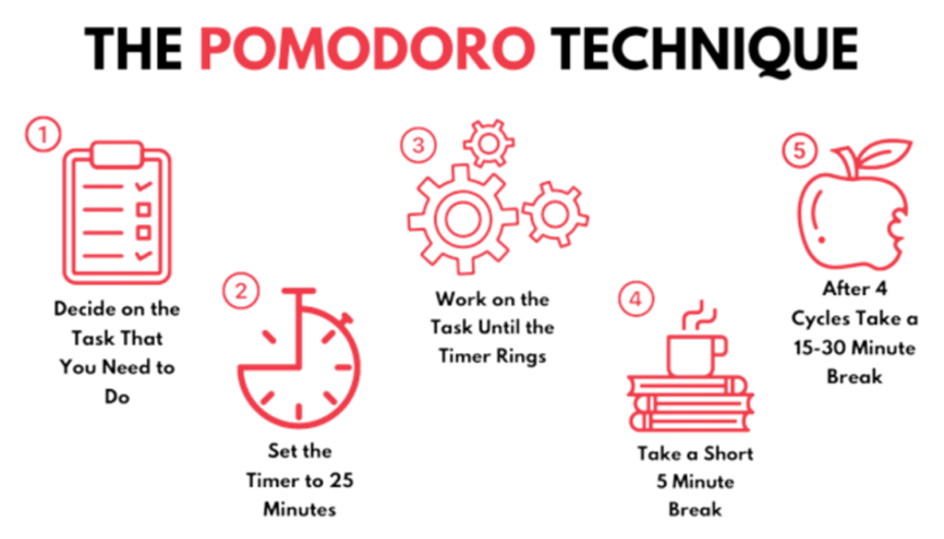
Milton Bain, IOCL
bainm@indianoil.in
Abstract
In an age where distractions abound and attention spans dwindle, the quest for productivity has become more critical than ever. Among the myriad of strategies and methods devised to combat procrastination and enhance focus, one technique stands out for its simplicity and effectiveness: the Pomodoro Technique.

Developed in the late 1980s by Francesco Cirillo, the Pomodoro Technique is a time management method that encourages individuals to work in focused intervals, typically 25 minutes long, separated by short breaks. The technique derives its name from the Italian word for “tomato” (Pomodoro), inspired by the tomato-shaped kitchen timer used by Cirillo during his university days.
Main Content
At its core, the Pomodoro Technique revolves around breaking down tasks into manageable segments called “Pomodoros” and employing a timer to track these intervals. Each Pomodoro session is dedicated to a single task, free from interruptions or multitasking, fostering deep concentration and flow state.

The simplicity of the Pomodoro Technique belies its profound impact on productivity and focus. Here’s how it works:
1. Set Clear Goals: Begin each work session by identifying the task or tasks you intend to accomplish. Clarify your objectives and break them down into smaller, actionable steps.

2. Set the Timer: Set a timer for 25 minutes—the duration of a typical Pomodoro session. During this time, commit to working on the designated task with undivided attention.

3. Work Intensely: Dive into your task with full concentration, striving to maintain focus for the entire duration of the Pomodoro. Resist the temptation to check emails, scroll through social media, or engage in unrelated activities.

4. Take a Short Break: Once the 25-minute Pomodoro session concludes, reward yourself with a short break lasting 5 minutes. Use this time to stretch, hydrate, or engage in a brief relaxation activity to recharge your mind.

5. Repeat the Cycle: After completing one Pomodoro session and the subsequent break, return to work for another focused interval. Repeat this cycle—25 minutes of work followed by a 5-minute break—until you’ve completed four Pomodoros.

6. Longer Break: After completing four Pomodoros, reward yourself with a more extended break, typically lasting 15-30 minutes. Use this time to rest, reflect on your progress, and prepare for the next work session.

The beauty of the Pomodoro Technique lies in its adaptability and flexibility. While the standard Pomodoro interval is 25 minutes, some individuals may find that shorter or longer intervals better suit their preferences and cognitive rhythms. Experimentation is encouraged to determine the optimal Pomodoro duration for maximum productivity.
Moreover, the Pomodoro Technique is not solely reserved for professional tasks or work-related activities. It can be applied to a wide range of endeavours, including studying, writing, creative projects, household chores, and even exercise routines. By breaking down daunting tasks into manageable chunks and allocating focused time intervals, individuals can overcome procrastination and make steady progress towards their goals.

Beyond its tangible benefits in enhancing productivity, the Pomodoro Technique offers psychological advantages as well. Imposing time constraints and promoting focused work intervals, alleviates feelings of overwhelm and anxiety associated with large or complex tasks.
The Pomodoro timer serves as a tangible symbol of progress, motivating individuals to stay on track and maintain momentum throughout their work sessions.
Furthermore, the structured nature of the Pomodoro Technique facilitates improved time management and prioritization. By allocating dedicated time blocks to specific tasks, individuals gain clarity on their priorities and allocate their resources more efficiently. This proactive approach minimizes the likelihood of succumbing to distractions or succumbing to the allure of procrastination.
Despite its effectiveness, the Pomodoro Technique is not without its challenges and limitations. Some individuals may struggle with maintaining focus for the entire duration of a Pomodoro session, especially if they’re accustomed to frequent distractions or multitasking. Overcoming these obstacles requires practice, discipline, and a willingness to cultivate mindfulness in one’s work habits.

Additionally, the Pomodoro Technique may not be suitable for every task or work environment. Certain types of work, such as creative brainstorming or collaborative projects, may benefit from longer periods of uninterrupted focus or spontaneous bursts of inspiration. In such cases, flexibility in adapting the Pomodoro Technique to accommodate specific needs and preferences is essential.
Conclusion:
In conclusion, the Pomodoro Technique stands as a powerful tool for enhancing productivity, managing time effectively, and cultivating focus in an age of constant distraction. Its simplicity, versatility, and proven effectiveness have earned it a devoted following among students, professionals, and creatives alike. By embracing the principles of focused work, periodic breaks, and mindful time management, individuals can harness the full potential of the Pomodoro Technique to achieve their goals and unleash their productivity.
In a world where time is a precious commodity and distractions lurk at every corner, mastering the art of the Pomodoro Technique offers a pathway to reclaiming control over one’s attention and maximizing one’s output. So, why wait? Grab your timer, set your goals, and embark on a journey of focused productivity with the Pomodoro Technique by your side.

Posted in Health & Wellbeing | No Comments »
Recent Articles
- Navigating Leaves: Balancing Connectivity and Breaks in Today’s Workplace
- Boost Your Productivity with the Pomodoro Technique
- The Busy Professional’s Guide to Self Care
- Mental Health @ Work
- Mental Health and Well-being
- Positivity: Why you should make a New Year’s Resolution
- Get To Know About Nomophobia
- Fuelling Health: Energy of Our Body
- Keep Running
- Is Living Alone a Curse or a Boon? No, It is an Art
- Living with Meaning: Workplace Spirituality, Mindfulness, and Purpose
- Delivering Happiness during Pandemic
- HUMRAHEE: We are in This Together
- CHETNA: Personal Connect during COVID 19
- Ecosystem Restoration @ BPCL
- Leading the Way: HR Initiatives during Pandemic
- Living with the Invisibile
- Resurrection
- Health and wellness- From benefits to necessity
- Personal Strategies to Improve Well-being-CALM ki baaten
- Sustainability as Competitive Advantage
- Cold Feet Before the Meeting! Does it Sound Familiar
- 9 Common Workout myths debunked
- Positive Psychology – Mantra of Well-being
- Human Resource Development Through Sports At Workplace
- Nature Heals_How to boost your brain power with nature
- Success Story of Waste Segregation
- Occupational Health & Safety Bulletin on : Managing MSDs (Musculoskeletal Disorder)
- Gratitude: The Game Changer Antidote to All The Dis-eases
- Effective Time Management
- Watch out and act now Prioritizing Mental Health at Work
- Pursuing a Passion Outside of Work for mental wellness
- Prioritizing Mental Health at Work
- Health or Help – what will you prioritize?
- Digital Wellbeing – Way towards Mental Health
- Love yourself the way you want others to
- Kissa Kursi Ka
- Atychiphobia: Understanding the fear of failure
- Is Yoga = Meditation? Let’s solve it
- Overcoming Failure
- From Surviving to Thriving: Building a Culture of Employee Well-being
- Solid Waste Management -A dire necessity
- Sleep health: The cornerstone of Wellbeing
- Miracle of Stress
- Health & Wellbeing in the Organization
